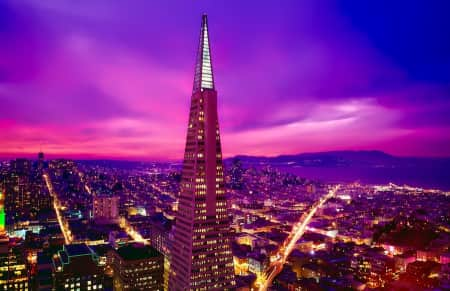The Struggles Behind Building the Transamerica Pyramid
The Transamerica Pyramid is one of the most photographed and highly recognizable buildings in the world. Although it is important as San Francisco’s second-tallest building in its skyline, it was not always as loved as it is today. Many would think that the toughest challenges facing building the Transamerica Pyramid would be combatting engineering issues, however, one of the tower's biggest challenges has been with public opinion. The Transamerica Pyramid was originally pitched to be 350m tall, which at that point would have been the 2nd tallest building in the world, following the Empire State Building. Despite designing a tapered tower that would maximize light at street level, the public was in an uproar over the building plans and feared the height of the building would lead to “Manhattanization”.
As well, people negatively viewed its futuristic design and described it as something you would see in Las Vegas. With so much opposition from the public, the plans for the tower were rejected. After receiving news of the rejection, the Transamerica team revised their plans and decreased the height of the tower to 260m. This change lowered the skyscraper's impact and prevented it from blocking the views from the prestigious Nob Hill neighborhood, which was a key issue in the building's approval. In spite of continued disapproval from the public, the pyramid's plans were approved, and construction began in 1969. However, once the building was finished in 1972, the city fell in love with the Skyscraper, and it quickly became an important landmark and a part of the city's culture.
Making the Transamerica Pyramid Earthquake Proof
Building in California comes with its own geographical struggles as one of the most seismically active regions in the United States. For this reason, when building in California builders must abide by some of the most rigorous building codes in the world. When the construction of the Pyramid began in 1969, the first step in securing the building was to excavate the site and fill a 2.7m thick base composed of 12,000 cubic meters of concrete and 480km of steel rebar. It took 3 days of continuous concrete pour to fill the base.
Next, extending from 15.5m below the ground, a four-story web made of steel and concrete wraps around the base of the building, contributing to the wide base that narrows as the building grows taller increasing the stability of the building. Finally, to protect from earthquakes the exterior of the building is reinforced with interior frames rising to the 17th floor and more interior frames then rising to the 45th floor.
Putting the Pyramid to the Test
The Transamerica Pyramid was carefully built to withstand intense earthquakes that the California area endures. The tower's structure was put to the test in 1989 when a 6.9 magnitude struck the city. The pyramid's advanced engineering held its own, reporting no serious injuries or structural damage despite having been shaken for more than a minute and the top floor swaying 30cm side to side.
Crown Jewel
At the top of the pyramid is a 32-pane glass encasement, often referred to as the “crown jewel”. Inside this enclosure is a 6000-watt beacon light that on special occasions is lit and visible all around the Bay Area. The journey to the tip of the pyramid is no easy task, after taking an elevator to the 48th floor, you must climb a steep set of stairs following another two ladders to ascend the 212-foot spire.
Is the Pyramid Open to the Public?
Unfortunately, the Transamerica Pyramid is no longer open to the public and can only be appreciated from the ground or from the virtual tour on the observation deck. At the base of the building is Redwood Park, an area where the public can appreciate the building's architecture.

